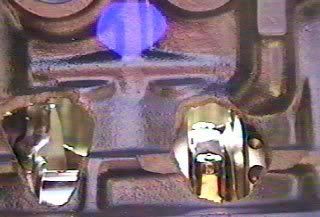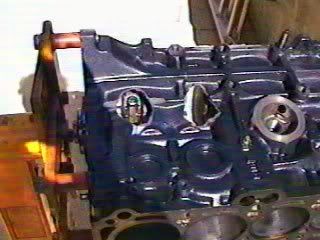
Welcome, from sunny Australia!
Crank, Con-rods, and Pistons

Crank, Con-rods, and Pistons
The standard equipment these days is of a
pretty high quality, and most probably the only part you'll need to
change is the pistons (maybe) and perhaps con-rod bolts. The crank is
often best left 'as is', with the only modifications really needed are a
general cleaning up of casting/forging dags, etc, and a polishing of the
bearing surfaces. While it's out of the engine, however, it's often
worth looking to see if any weight can be removed safely and to get it
shot peened after a careful balancing.
By the way, it's a common myth that shot
peening increases the strength of a component. Wrong! All it does is
give the surface of the component a tough skin and tends to remove any
stress points on the surface that could possibly be a crack starter. So
- If two identical cranks, with one shot peened and the other not, were
revved until they broke, the untreated one would break first, thus
giving the illusion of lesser strength than the treated one, when in
fact the untreated one simply broke from a unnecessary stress crack, the
metal in it being every bit as good as the other treated crank. Perhaps
a better view of shot-peening is to think that it stops the crank or
whatever from being weak.
For really high revs, the
counterweights on the crank should be knife-edged to reduce wind drag
and drag when the crank hits the sump oil. It's also well worth checking
the crank for straightness, though you may get an unpleasant surprise,
and have to get the crank straightened.
The same process for con-rods, but they must
be balanced end-for-end and also made equal weights to each other. The
con-rod bolts are much better these days than in past, but if there's
any doubt go out and get a set of ARP (or equivalent) rod bolts for your
engine. If the correct bolts aren't available, you might consider a set
that's got a slightly larger diameter and reaming the con-rods to suit.
The important thing with con-rod bolts are snugness of fit, ie, no
matter which end the bolt goes through (Some come up through the cap),
it must have a slight interference fit (0.0005" or so) and that
interference must continue through to the other side of the con-rod so
the cap (or main part) fits very accurately on the other half. The head
of the bolt must fill the available area as much as possible, and the
threaded part of the bolt must only be just long enough to
cover the retaining nut. Every time you strip down the engine, replace
the bolts - DO NOT REUSE THEM!! (Put them to good use - Give them to
someone you want to beat!) Shot peen after balancing, etc
Remember - Most engines fail
spectacularly because of the con-rod bolts failing!
The pistons are also quite important, and if
you have the sort with a slot milled into them in the oil ring groove,
them keep them as ashtrays. The only good pistons have holes
drilled in the oil groove, and perhaps a few more holes just below the
ring groove. (Don't try this at home though) Good pistons also have thin
rings, eg, the #1 compression ring may only be 1mm (0.040") thick, the
#2 slightly thicker, and the oil control ring not much thicker again.
Good gudgeon pins are tapered so they weigh less than parallel pins.
Ceramic coating is also a good thing to keep the heat where it should be
instead of the engine oil, etc. Remove all sharp edges and balance
carefully, matching weights as a set. Do NOT shot peen.
 |
This
is the sort of thing you can expect if you over-rev the engine once too
often. This is a 4AGE that has been revved way past the sensible limit,
as it was revved to 9500rpm odd when it really should only go to about
8500rpm. One rod let go, then out of sympathy the one next to it
followed ... |
 |
Continue on to -
The block - Other stuff - Other
Tuning - Further reading and race car sounds
For more motorsport links, try the motorsport section on my links page.
Back to the Index page
Page & contents where applicable © Bill Sherwood